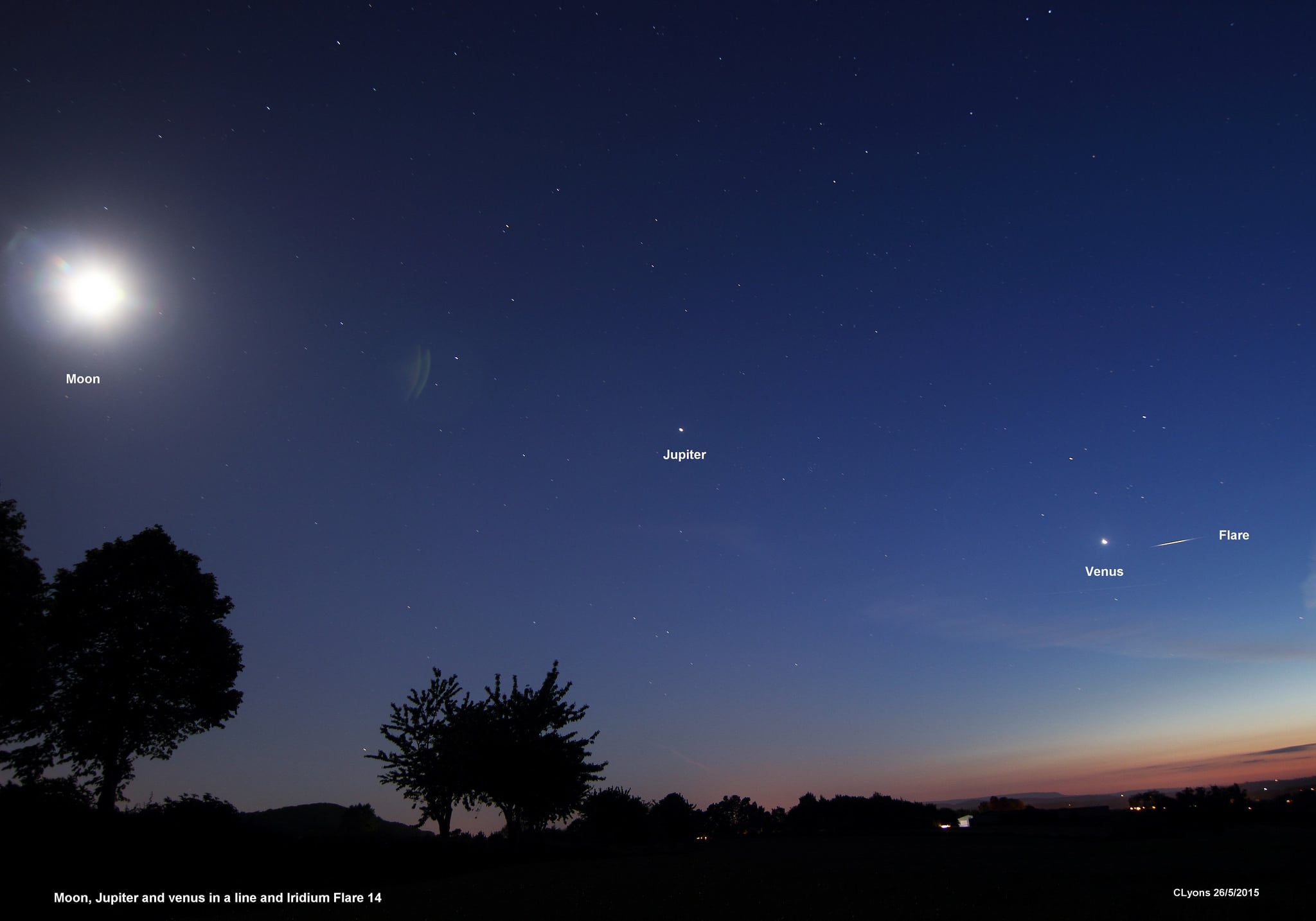Are you ready to hear an upswing in queries from friends/family and/or strangers on Twitter asking "what are those two bright stars in the evening sky?"
It's time to arm yourself with knowledge against the well-meaning astronomical onslaught. The month of June sees the celestial action heat up come sundown, as the planet Jupiter closes in on Venus in the dusk sky. Both are already brilliant beacons at magnitudes -1.5 and -4 respectively, and it's always great to catch a meeting of the two brightest planets in the sky.
[caption id="attachment_120620" align="alignnone" width="1019"]
Looking west on the evening of June 5th from latitude 30 degrees north... Image credit:
Stellarium
[/caption]
Be sure to follow Venus and Jupiter through June, as they close in on each other at a rate of over ½ a degree—that's more than the diameter of a Full Moon—per day.
[caption id="attachment_120621" align="alignnone" width="829"]
...and looking west on the evening of June 20th...[/caption]
Venus starts June at 20 degrees from Jupiter on the first week of the month, and closes to less than 10 degrees separation by mid-month before going on to a final closing of less than one degree on the last day of the June. Th climax comes on July 1
st
, when Venus and Jupiter sit just over 20' apart—2/3rds the diameter of a Full Moon—on July 1
st
at 3:00 UT or 11:00 PM EDT (on June 30
th
). This translates to a closest approach on the evening of June 30
th
for North America.
[caption id="attachment_120622" align="alignnone" width="821"]
... and finally, looking westward on the evening of July 1st.[/caption]
Venus starts the first week of June forming a straight line equally spaced with the bright stars Castor and Pollux in the astronomical constellation Gemini. On June 12-13, Venus actually
nicks
the Beehive cluster M44 in the constellation Cancer, a fine sight through binoculars.
[caption id="attachment_120625" align="alignnone" width="1024"]
The apparent paths of Venus versus Jupiter through the month of June. Credit:
Starry Night Education software
[/caption]
Jupiter and Venus will then be joined by the Moon on the evening of June 20
th
to form a skewed 'smiley face' emoticon pairing. Not only is the pairing of Venus and the crescent Moon represented on many national flags, But the evening of June 20
th
will also be a great time to try your hand at
daytime planet spotting
before sunset, using the nearby crescent Moon as a guide.
[caption id="attachment_120619" align="alignnone" width="913"]
The daytime view of Venus, the Moon and Jupiter of the evening of June 20th. Image Credit:
Stellarium
[/caption]
The Moon will actually occult Venus three times in 2015: On
July 19th
as seen from the South Pacific, on
October 8th
as seen from Australia and New Zealand, and finally, on
December 7th
as seen from North America in the daytime.
This conjunction of Venus and Jupiter occurs just across the border in the astronomical constellation of Leo. As Venus can always be found in the dawn or dusk sky, Jupiter must come to it, and conjunctions of the two planets occur roughly once every calendar year. A wider dawn pass of the two planets occurs this year on October 25
th
, and in 2019 Jupiter again meets up with Venus twice, once in January and once in November. The last close conjunction of Venus and Jupiter occurred on
August 18th, 2014
, and an extremely close (4') conjunction of Venus and Jupiter is on tap for next year on August 27
th
. Check out our nifty
list of conjunctions
of Venus and Jupiter for the remainder of the decade from last year's post.
The view through the telescope on the evenings June 30
th
and July 1
st
will be stunning, as it'll be possible to fit a 34% illuminated 32" crescent Venus and a 32" Jupiter plus its four major moons all in the same low power field of view. Jupiter sits 6 astronomical units (AU) from Earth, and Venus is 0.5 AU away on July 1
st
.
[caption id="attachment_120623" align="alignnone" width="1024"]
Looking at Jupiter and Venus on July 1st using a 30 arc minute filed of view. Image credit:
Starry Night Education Software
[/caption]
And just think of what the view from
Jupiter
would be like, as Venus and Earth sit less than 3 arc minutes apart:
[caption id="attachment_120624" align="alignnone" width="1024"]
The view from Jupiter on July 1st looking at the Earth. Image credit:
Starry Night Education software
[/caption]
Venus reaches solar conjunction this summer on August 15
th
, and Jupiter follows suit on August 26
th
.
Both enter the field of view
of the European Space Agency's Solar Heliospheric Observatory (SOHO) LASCO C3 camera in mid-August, and are visible in the same for the remainder of the month before they pass into the dawn sky.
But beyond just inspiring inquires, close conjunctions of bright planets can actually raise
political
tensions as well. In
2012, Indian army sentries reported
bright lights along India's mountainous northern border with China. Thought to be reconnaissance spy drones, astronomers later identified the lights as Venus and Jupiter, seen on repeated evenings. We can see how they got there; back in the U.S. Air Force, we've seen Venus looking like a 'mock F-16 fighter' in the desert dusk sky as we recovered aircraft in Kuwait. Luckily, cooler heads prevailed during the India-China incident and no shots were exchanged, which could well have led to a wider conflict…
Remember: Scientific ignorance can be harmful, and astronomical knowledge of things in the sky can save lives!
 Universe Today
Universe Today
